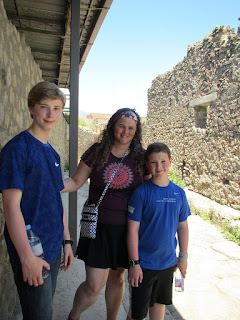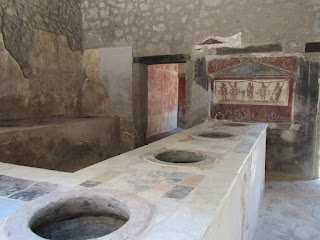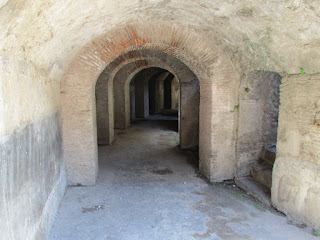

The city of Pompeii was established around 600 BC. It was independent of Rome until 89 BC, when it was annexed into the Roman Empire. In the Fall of 79 AD, the nearby volcano, Mount Vesuvias, erupted, sending hot flows of gas and debris into Pompeii, ultimately burying it in ash where it would remain covered until 1599.

Rediscovered in 1599, the site has since been cleaned of most of the 15 feet of compacted ash that remained, uncovering a perfectly-preserved view of life in the first century. Food in ovens, plants in gardens, human remains, all found in exactly the position they were on the day of the eruption nearly 2,000 years ago. Here, the walls and streets of the town have been uncovered, and the gardens have been restored to the way they looked on the day of the eruption.

Unlike most other ancient sites, Pompeii was not re-built many times over the centuries, so we can walk down the streets today and see the town as it was laid out in the first century. Even the marble covering for the brickwork remains, since no rock-robbers were able to take it, buried deep beneath the ash.

The city center provides a grand view of life in Pompeii 2,000 years ago.

Hot gas, nearly 500 deg F, flowed from the volcano down to Pompeii, instantly killing men, women, children and pets. Then ~80 feet of ash fell (eventually compacting to ~15 feet), covering the human and pet remains. Once found in the modern era, these remains had left a void in the hardened ash, and casts could be made to show the exact position and expressions of those humans and pets who died in Pompeii. Here a pet dog's casting shows the position it was in when the hot gas hit the town.

More casts showing the human remains found in Pompeii. Note the variety of ages, sizes and expressions still visible on the faces of those who died from the heat and ash.

Whole families were found, sometimes embracing each other as the hot flow of gas filled the city.

The Garden of Fugitives, showing the positions of many as they fell. These bodies were discovered in 1961 (much of the recovery is still ongoing even today). These people had evacuated to the outskirts of the city after the first day, but on the second day of the eruption, the worst flow of hot gas filled the remainder of the city and they succumbed where they fell. They are just 13 of the ~2,000 people who lost their lives in Pompeii during the eruption. Over 1,100 voids have been found in the ash marking the locations of the deceased victims, but less than a hundred have been casted with plaster for study. These thirteen are among that number. The man overseeing the recovery had this to say about the story behind these bodies:
"When the band [of thirteen fugitives] decided to flee, first [in this family group] came a servant, carrying over his shoulder a bag hastily filled with provisions. We found him where he fell, near the wall of a vegetable garden.... Next, hand in hand, came the farmer's two little boys of about four and five... Finally came the children's parents, the farmer supporting his trembling wife. ,
Behind the farmer's family came a young farm couple with their daughter.... In the case of the daughter, the stream of plaster failed us. We have only the vague outline of what seems to be a slender, undernourished child.
Last came the merchant's family--two young boys in their teens, followed by their mother and a younger sister.... The final figure in that pageant of death was the merchant, to me the most tragic of the group. He was not lying down but still sitting upright with his right arm pressed against a mound of earth and his back bent in a supreme effort to rise...."

Walking the streets of Pompeii, feeling like we should be in Roman sandals and Roman-era clothing, as you get an authentic feel of walking down a first-century Roman city.

Many of the dwellings have counters, like the one in the left on this picture, not too much different than the granite counter-tops seen in modern kitchens.

The streets of Pompeii were paved with large cobblestones.

And, yes, Alaska is not the only place to suffer from ruts in the paved road. Except in Pompeii it was the iron strip around the perimeter of the wooden cart wheels that ground the cobbled street into ruts (instead of metal spikes on our winter tires).

In one of the dwellings, the boys pretend to be bartender and customer at the "drink" counter.

Lavish decorations in one of the dwellings, with small statues holding up a ceiling decorated with frescoes and carvings.

Walking down the streets of Pompeii.

In a courtyard in the ancient city of Pompeii. Gardens have been re-planted to match the plant types found under the buried ash.

A lavish mansion's courtyard from the first-century AD.

Decorations on the walls behind the boys show the colors and patterns used to decorate the homes.

Mosaic floor in one of the larger dwellings.

Fresco of Roman scene overlooking a well-built counter.

Unusual statue in the city center.

The amphitheater (coliseum style) built in Pompeii.

The entrance to the amphitheater.

The amphitheater underground access.

Outside of the amphitheater.

Standing along the columns in the Grand Palace.


The above two paintings were art previously visible on the walls in the ruins where they were created (last time I was here in 2001 I saw them there), but they have now been moved into the Grand Palace, which was restored recently, and put behind glass. They depict two different angels, and I find it interesting to see what a first-century artist would have perceived an angel to look like, since they lived so much closer to the time-frame when scripture tells us angels did appear to some. It is likely that Jesus was a child or young man growing up in Nazareth when these depictions of angels were being painted in Pompeii.

We are staying in the small town of Pozzuoli on the coast near Naples. Our BnB here is a house right on the water, and when it is clear, you can see the Isle of Capri in the distance (wasn't clear enough in this picture, so those islands are smaller islands closer to us).

No comments:
Post a Comment